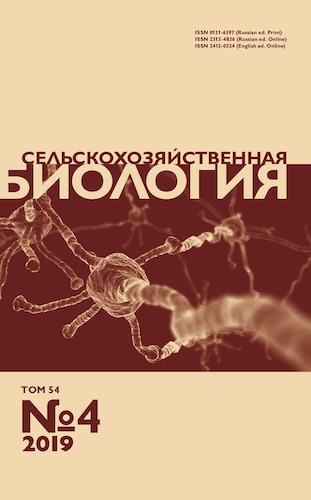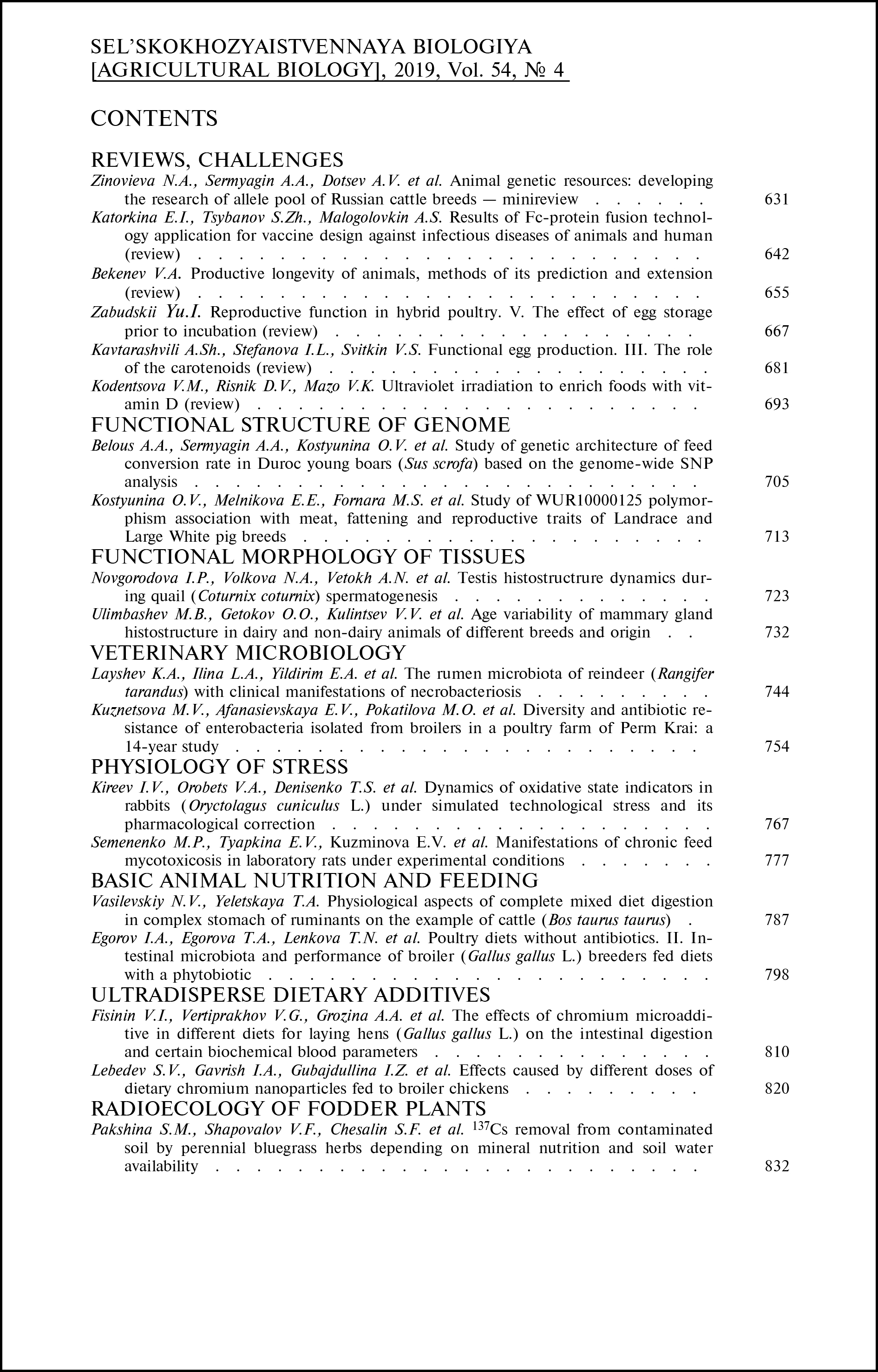doi: 10.15389/agrobiology.2019.4.810eng
UDC: 636.52/.58:591.1:636.085.12:546.763
Acknowledgements:
Supported financially by the Program on study of the mechanisms of digestive adaptation of mammals and poultry to different diets (Resolution of the Presidium RAS No. 132, dated 05.07.2017).
THE EFFECTS OF CHROMIUM MICROADDITIVE IN DIFFERENT DIETS FOR LAYING HENS (Gallus gallus L.) ON THE INTESTINAL DIGESTION AND CERTAIN BIOCHEMICAL BLOOD PARAMETERS
V.I. Fisinin, V.G. Vertiprakhov, A.A. Grozina, I.V. Kislova,
M.V. Kosheyeva
Federal Scientific Center All-Russian Research and Technological Poultry Institute RAS, 10, ul. Ptitsegradskaya, Sergiev Posad, Moscow Province, 141311 Russia, e-mail Vertiprakhov63@mail.ru (✉ corresponding author), olga@vnitip.ru, Alena_fisinina@mail.ru, irina.kislova1606198@yandex.ru, vlk.733@mail.ru
ORCID:
Fisinin V.I. orcid.org/0000-0003-0081-6336
Kosheyeva M.V. orcid.org/0000-0002-0744-1883
Vertiprakhov V.G. orcid.org/0000-0002-3240-7636
Kislova I.V. orcid.org/0000-0001-6399-6886
Grozina A.A. orcid.org/0000-0001-9654-7710
Received April 4, 2019
Cromium (Cr) is a biogenic element necessary for normal growth and development in animals and poultry. Cr regulates the synthesis of fats, carbohydrate exchange, and circulatory glucose concentration. Cr additives in the diets were reported to affect growth efficiency positively in broiler chicks (I.Z. Gubaydulina et al., 2018); supplementation of diets with Cr nanoparticles (100-200 ppb) stimulated mineral exchange in broilers. With the lack of the research related to the effects of Cr microadditives on the digestion in animals and the absence of the studies on animals with chronic intestinal fistulae, the aim of our study was to investigate the effects of Cr microadditive (100 ppb) as nanoparticles in different wheat-based diets for laying hens (with soybean cake or sunflower cake as main protein sources) on the intestinal digestion and certain biochemical blood parameters. The trial was performed on Hisex White chicken (Gallus gallus L.) (10-12 months of age, 5 birds per treatment, diet shifts in 7-10 day periods) with chronic duodenal fistulae. Cr (III) oxide (99.8 %) nanoparticles (d = 91 nm, specific surface area 9 m2/g, Z-potential 93±0.52 mV) (Platina LLC, Moscow, Russia) were produced by plasmochemical synthesis. The activities of amylase, lipase and total proteases were determined in the duodenal digesta sampled in 1 hour after the feeding. The blood was sampled from the axillary vein in the morning from starved birds and centrifuged with sodium citrate to obtain serum. The activities of trypsin and alkaline phosphatase, concentrations of glucose, total protein, triglycerides, uric acid, alanine and aspartic acid transaminases in serum were determined using semiautomatic flow biochemical analyzer BS-3000P (SINNOWA Medical Science & Technology Co., Ltd, China). The activities of amylase and lipase in serum were determined using analyzer Chem Well 2900 (T) (Awareness Technology, USA) and reagent kits (Human GmbH, Germany). Cr microadditive was found to produce different effects within different diets. The digestibility of protein and fiber from the diets with sunflower cake tended to be higher in compare to soybean cake. When the birds were fed Cr-supplemented diets the serum amylase activity increased by 37.8-50.2 % irrespective of the diet, with simultaneous reduction in serum glucose concentration by 26.6-17.5 % evidencing the improvement in glucose assimilation. The latter is in agreement with the negative correlation between the activity of amylase in the duodenal digesta and serum glucose concentration (r = -0.72 and -0.45 for different diets, р < 0.05). The supplementation of soybean-based diet with Cr decreased the duodenal activity of lipase with simultaneous reduction in certain biochemical blood parameters by 22-40 %; however, these parameters remained within the physiologically normal ranges. The supplementation of sunflower-containing diet with Cr increased duodenal activities of amylase, lipase, and total proteases; it is probably related to the presence of antinutritive factors in sunflower cake. These results lead to the conclusion that the effects of Cr oxide nanoparticles depend on the composition of basic diet; this fact one should take into account in practice of poultry nutrition.
Keywords: Gallus gallus L., laying hens, duodenal digesta, activities of digestive enzymes, digestive enzymes in blood serum, chromium (III) oxide.
REFERENCES
- Kargar S., Mousavi F., Karimi-Dehkordi S., Ghaffari M.H. Growth performance, feeding behavior, health status, and blood metabolites of environmentally heat-loaded Holstein dairy calves fed diets supplemented with chromium. Journal of Dairy Science, 2018, 101(11): 9876-9887 CrossRef
- Yudina T.A., Seryakov I.S. Zhivotnovodstvo i veterinarnaya meditsina, 2013, 2: 9-14 (in Russ.).
- Oganyan A.A., Neelova O.V. Uspekhi sovremennogo estestvoznaniya, 2011, 8: 227-229 (in Russ.).
- Wang M.Q., Xu Z.R., Zha L.Y., Lindemann M.D. Effects of chromium nanocomposite supplementation on blood metabolites, endocrine parameters and immune traits in finishing pigs. Animal Feed Science and Technology, 2007, 139(1-2): 69-80 CrossRef
- Wei X., Hu L.L., Chen M.L., Yang T., Wang J.H. Analysis of the distribution pattern of chromium species in single cells. Anal. Chem., 2016, 88(24): 12437-12444 CrossRef
- Kononskii A.I. Biokhimiya zhivotnykh [Animal biochemistry]. Moscow, 1992 (in Russ.).
- Prostokishin A.S., Babukhadiya K.R., Nimaeva V.Ts., Krasnovskii K.A., Gornaya E.N. Zootekhniya, 2014, 4: 16-17 (in Russ.).
- Gubaidulina I.Z., Gavrish I.A., Markova I.V., Mustafina A.S. Izvestiya Orenburgskogo gosudarstvennogo agrarnogo universiteta, 2018, 6: 263-265 (in Russ.).
- Tahami Z., Hosseini S.M., Bashtani M. Effect of organic acids supplementation on some gastrointestinal tract characteristics and small intestine morphology of broiler chickens. Animal Production Research, 2014, 3(3): Pe1-Pe9.
- Anderson R.A. Chromium and insulin resistance. Nutrition Research Reviews, 2003, 16(2): 267-275 CrossRef
- Saeed A.A., Sandhu M.A., Khilji M.S., Yousaf M.S., Rehman H.U., Tanvir Z.I., Ahmad T. Effects of dietary chromium supplementation on muscle and bone mineral interaction in broiler chicken. Journal of Trace Elements in Medicine and Biology, 2017, 42: 25-29 CrossRef
- Piotrowska A., Pilch W., Tota L., Nowak G. Biological significance of chromium III for the human organism. Medycyna Pracy, 2018, 69(2): 211-223 CrossRef
- Rao S.V., Prakash B., Raju M.V., Panda A.K., Kumari R.K., Reddy E.P. Effect of supplementing organic forms of zinc, selenium and chromium on performance, anti-oxidant and immune responses in broiler chicken reared in tropical summer. Biological Trace Element Research, 2016, 172(2): 511-520 CrossRef
- White P.E., Vincent J.B. Systematic review of the effects of chromium(III) on chickens. Biological Trace Element Research, 2019, 188(1): 99-126 CrossRef
- Merina-Gluzkina V.M. Laboratornoe delo, 1965, 3: 142-146 (in Russ.).
- Batoev Ts.Zh. Sbornik nauchnykh trudov Buryatckogo SKHI (Ulan-Ude), 1971, 25: 122-126 (in Russ.).
- Vertiprakhov V.G., Grozina A.A. Veterinariya, 2018, 12: 51-54 CrossRef
- Batoev Ts.Zh. Fiziologiya pishchevareniya ptits [Physiology of digestion in birds]. Ulan-Ude, 2001 (in Russ.).
- Fisinin V.I., Egorov I.A., Vertiprakhov V.G., Grozina A.A., Lenkova T.N., Manukyan V.A., Egorova T.A. Activity of digestive enzymes in duodenal chymus and blood in broilers of parental lines and the meat cross depending on dietary bioactive additives. Sel'skokhozyaistvennaya biologiya [Agricultural Biology], 2017, 52(6): 1226-1233 CrossRef
- Liu L., Zhang S.W., Lu J., Pang X.Y., Lv J.P. Antidiabetic effect of high-chromium yeast against type 2 diabetic kk-ay mice. Journal of Food Science, 2018, 83(7): 1956-1963 CrossRef
- Egorov I.A., Petrosyan A., Andrianova E.N. Ptitsevodstvo, 2011, 12: 3-5 (in Russ.).
- Nikulin V.N., Skitsko E.R. Izvestiya Orenburgskogo gosudarstvennogo agrarnogo universiteta, 2017, 3: 167-169 (in Russ.).
- Titov V.N., Tvorogova M.G. Klinicheskaya laboratornaya diagnostika, 1992, 9-10: 5-11 (in Russ.).
- Serr J., Suh Y., Lee K. Regulation of adipose triglyceride lipase by fasting and refeeding in avian species. Poultry Science, 2009, 88(12): 2585-2591 CrossRef
- Mozheiko L.A. Zhurnal Grodnenskogo gosudarstvennogo meditsinskogo universiteta, 2016, 3: 18-23 (in Russ.).
- Wang C., Chen Z., Pan Y., Gao X., Chen H. Anti-diabetic effects of Inonotus obliquus polysaccharides-chromium (III) complex in type 2 diabetic mice and its sub-acute toxicity evaluation in normal mice. Food and Chemical Toxicology, 2017, 108(part B): 498-509 CrossRef
- Tsuda Y., Iwasawa K., Yokoyama M., Yamaguchi M. Trypsin-treated β-lactoglobulin improves glucose tolerance in c57BL/6 mice by enhancing AMPK activation and glucose uptake in hepatocytes. Biological and Pharmaceutical Bulletin, 2017, 40(11): 1917-1922 CrossRef
- Fisinin V.I., Vertiprakhov V.G., Grozina A.A. Rossiiskaya sel'skokhozyaistvennaya nauka, 2018, 1: 49-53 (in Russ.).
- Turgut M., Cinar V., Pala R., Tuzcu M., Orhan C., Telceken H., Sahin N., Deeh P.B.D., Komorowski J.R., Sahin K. Biotin and chromium histidinate improve glucose metabolism and proteins expression levels of IRS-1, PPAR-γ, and NF-κB in exercise-trained rats. Journal of the International Society of Sports Nutrition, 2018, 15(1): 45 CrossRef
- Ngala R.A., Awe M.A., Nsiah P. The effects of plasma chromium on lipid profile, glucose metabolism and cardiovascular risk in type 2 diabetes mellitus. A case — control study. PLoS ONE, 2018, 13(7): e019797 CrossRef
- Lebedev S.V., Gavrish I.A., Gubaidullina I.Z. Different chrome sources influence on morpho-biochemical indicators and activity of digestive enzymes in Wistar rats. Sel'skokhozyaistvennaya biologiya [Agricultural Biology], 2019, 54(2): 304-315 CrossRef
- Singh S.P., Chinde S., Kamal S.S., Rahman M.F., Mahboob M., Grover P. Genotoxic effects of chromium oxide nanoparticles and microparticles in Wistar rats after 28 days of repeated oral exposure. Environmental Science and Pollution Research, 2016, 23(4): 3914-3924 CrossRef












